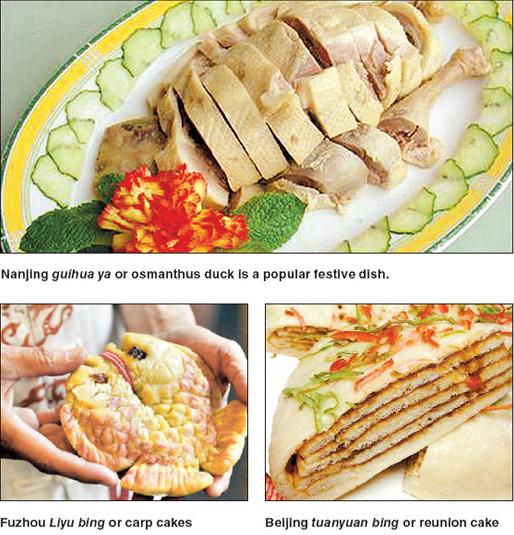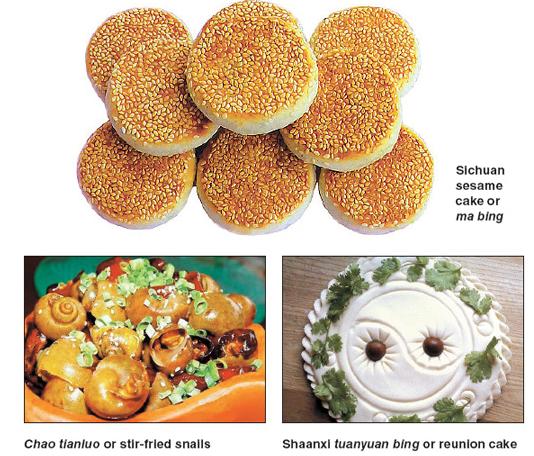| Home > China Feature |
Popular Food for the Coming Mid-autumn Festival
Mid-autumn Festival is drawing near, now let me share the best diet with you~
Mooncakes, or yuebing, are the symbol of the Mid-Autumn Festival. Whether sweet or savory, mooncakes are the must-haves around China. At the same time, different regions celebrate the festival with different traditions and, of course, different food.
The ancient harvest festival, this year falling on September 30, is sometimes called the Moon Festival. It originated in worship and appreciation of the moon. In ancient times, food offerings were made to the full moon. The round cakes also symbolize family reunion.
Mooncake pastries can be sweet or savory, filled with nuts such as almonds, seeds, dates, lotus paste, red bean paste, as well as meat and a salted duck egg yolk. The fillings also depend on the region where mooncakes are made and local tastes.
In Shanghai, the traditional festive food for celebrating Mid-Autumn Festival includes, in addition to mooncakes, taro root and jiang ya (酱鸭) or duck seasoned with soy sauce. Drinking osmanthus wine is also a tradition, and the sweet scent of the seasonal osmanthus flower makes the wine more special.
Diverse customs around China result from regional differences, according to Zhong Fulan, a professor specializing in folk traditions at East China Normal University. During the festival, many activities are centered on admiring the full moon.
In the Western Zhou Dynasty (c. 11th century-770 BC), mooncakes and watermelon were essential during ceremonies. The watermelon, signifying fertility because of its many seeds, was carved into the shape of a lotus, an auspicious symbol.
In the Ming (1368-1644) and Qing (1644-1911) dynasties, many Mid-Autumn Festival ceremonial activities were retained. Some areas developed special customs such as fire dragon dances and lighting up towers with lanterns.
Different tastes
Different provinces feature seasonal, local foods. In the region south of the Yangtze River, eating pumpkins is a tradition on the Mid-Autumn Festival.
It is said long time ago, a girl named Huang Hua from a poor family was taking care of her sick parents. On August 15 on the lunar calendar, she took home two pumpkins and cooked them for her parents, who regained their health. Huang planted the pumpkin seeds and harvested more the following year. Nowadays, many families in the region cook pumpkin with glutinous rice (老南瓜烧糯米粉) in mid-August (lunar calendar).

In Fuzhou, capital city of Fujian Province, there's a nearly forgotten tradition of serving carp cakes, or liyu bing (鲤鱼饼), according to Fang Xianghong from the Fujian Academy of Social Sciences.
Carp cake is made of flour - no fish at all - and has the same kind of fillings as mooncakes, but it is decorated with two carp, symbolizing "carp jumping over the dragon gate." The saying refers to the fish swimming against the current, signifying striving and high achievement.
"Usually mooncakes are given to the children by their parents and paternal grandparents, while carp cakes are given by maternal grandparents," Fang says.
However, carp cakes are not easy to find and many people have forgotten the custom. A company in Fuzhou has started making the carp cakes to keep the tradition alive.
In Guangdong Province, stir-fried snails or chao tianluo (炒田螺) are popular during the festival; it's also the best season to eat the snails. The dish is seasoned with minty perilla leaf, essential to remove the fishy odor, and dou chi (豆豉) or fermented soy beans.
"It's salty and a little spicy, and with a hint of sweetness," says Feng Enya, a resident of Guangzhou, capital city of Guangdong Province.

In Beijing, a traditional sweet treat is called tuanyuan bing (团圆饼), meaning "reunion cake." It was very popular in old times and families used to make it every year.
It's a big, steamed wheat-flour bun with four or five layers spread with brown sugar and sometimes sesame seeds and nuts.
Unlike mooncakes, which are more of a dessert, tuanyuan bing can be served as a meal.
In Shaanxi Province, there's a speciality cake or bun known as tuanyuan mo (团圆馍), meaning "reunion bun." It's very large and can be shared by a family. It contains sesame filling and can be seasoned with sesame oil, salt or sugar.
It's decorated and served with a piece of cilantro leaf, also known as coriander or Chinese parsley, on top.
It is traditionally shared by the whole family, and some pieces are saved for family members who are unable to be present. Watermelon is also essential during the festival.
In Jimo City, Shandong Province, it's customary to eat mai jian (麦箭) or "wheat arrow" during the Mid-Autumn Festival. Flour pancakes are filled with meat or vegetables and a stalk of sorghum, then they are rolled, steamed and served with seasoning or sauce.
Eating duck is popular during the festival because duck is very rich and tasty during this season. In traditional Chinese medicine, duck is a "cold" (yin energy) food frequently served at this time of year.
In Nanjing, capital city of Jiangsu Province, salted duck is popular for the Mid-Autumn Festival dinner table.
It is also called guihua ya (桂花鸭) or osmanthus duck, because osmanthus flowers bloom during the season. A festival tradition, the duck is cooked with taro root.
In Sichuan Province, smoked duck or yan xun ya (烟熏鸭) is a popular main course. The duck is pickled in salt, boiled until the skin is tight, smoked in an oven and then placed briefly in brine and spices.
People in Sichuan also eat ma bing (麻饼), meaning sesame cake, a crispy pastry made with flour, brown sugar, sesame and other ingredients.
The Mid-Autumn Festival has diverse traditions and regional foods. Though mooncakes are dominant, regional specialities reflect the spirit of the festival and bring back old-time memories.
Art
 more
moreChina Beijing International Diet ...
Recently, The hit CCTV documentary, A Bite of China, shown at 10:40 ...

Exhibition of Ancient Chinese Jad...
At least 8,000 years ago, Chinese ancestors discovered a beautiful...

Longmen Grottoes
The Longmen Grottoes, located near Luoyang, Henan Province, are a tr...

Custom
 more
moreWeb Dictionary
Martial Arts
Tai Chi Master Class Held in Moscow
MOSCOW, June 15, 2016 (Xinhua) -- Students learn from Shaolin ...
Celebriting 70 years' efforts in restoring Mogao...
Work is being carried out at the restoration site of cave No 98 a...
Hong Kong Children's Symphony performs in Seattle
Under the theme of Tribute to the Golden Age, a concert featuring a ...





 print
print  email
email  Favorite
Favorite  Transtlate
Transtlate 








